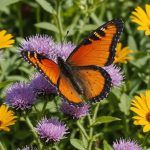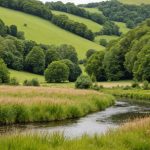Understanding Dormice and Their Habitat Needs
Dormice are more than adorable creatures; they are integral to maintaining a balanced garden ecosystem. Endangered species like dormice reflect the health of broader ecological systems. Recognizing their ecological importance is the first step toward effective conservation efforts.
In the UK, dormice have specific habitat requirements critical for their survival. These small rodents require diverse environments rich in native plants and trees. Such vegetation offers them essential resources, including food and shelter. Colourful flowering plants attract insects that serve as food for dormice, underscoring the interconnectedness of species within a thriving ecosystem.
Additional reading : Sustainable Boating in the UK: Essential Tips to Safeguard Freshwater Habitats and Marine Life
Native hedgerows and woodland plants like honeysuckle, hazel, and bramble provide ideal conditions. They not only offer cover but also nesting sites, crucial for dormice breeding. A garden ecosystem rich with varied plant life ensures dormice can thrive, relying on natural interdependence.
When considering dormice’s role in the ecosystem, their endangered status in the UK emphasizes the need for mindful habitat creation and restoration. In doing so, gardeners not only support this specific species but contribute to a healthier, more resilient environment. By planting and preserving the right types of flora, we can create sanctuaries that cater to the complex needs of dormice and other endangered species.
In the same genre : Boosting UK Farmers’ Impact: Eco-Friendly Farming to Safeguard Barn Owl Habitats
Practical Steps for Creating a Safe Haven
Designing a dormice-friendly garden requires thoughtful planning and integration of native plants. Begin by ensuring cover for dormice, which can be achieved through dense shrubs and hedgerows. Additionally, providing various nesting sites, like hollow logs or tree boxes, fosters a safer environment for dormice populations to thrive.
Food sources are crucial in supporting dormice, and gardens should feature plenty of flowering plants and fruit-bearing shrubs. Essential plant species include honeysuckle and hazel, which offer sustenance and attract insects. This variety in plant life ensures a steady supply of nutrients throughout the seasons, crucial for dormice survival.
Landscape connectivity is vital. Create corridors that link garden sections, allowing dormice to move freely and access diverse resources safely. Rows of trees or connected hedgerows provide these essential routes within the garden framework, supporting the survival of these endangered species.
Incorporate diverse ecological layers and consider the balance of light, water, and shade. Avoid chemical pesticides that can harm both dormice and their food sources. Adopting environmentally friendly garden practices supports the broader wildlife conservation effort, fostering a garden ecosystem that is vibrant and sustainable for dormice and other species.
Plant Recommendations for Dormouse Gardens
A successful dormouse garden begins with selecting native plants that cater to these creatures’ needs. Fruit-bearing shrubs like hazel are not just attractive additions but vital food sources. Together with trees such as oak and willow, these plants deliver both nourishment and shelter.
Integrating flowering plants such as wild garlic, bluebells, and honeysuckle enhances the garden’s appeal and supports local insect populations. These flowers encourage a diverse range of insects, which in turn become food for dormice. The interdependence between plants and insects is crucial, reinforcing the garden’s overall biodiversity.
When planning your garden, create a layered planting scheme. This involves arranging plants at varying heights, from ground cover to taller trees, mimicking a natural woodland setting. Such designs provide cover and material diversity, allowing dormice to move freely and safely.
By incorporating a variety of native plants, gardeners not only support dormouse populations but contribute to broader wildlife biodiversity, fostering a thriving garden ecosystem. These efforts bridge the gap between structured gardens and natural habitats, promoting a balance essential for the survival and prosperity of the dormouse and other species.
Legal Considerations for Protecting Dormice
In the UK, safeguarding dormice and their habitats involves navigating a framework of conservation laws dedicated to protecting these endangered species. Legal measures ensure that efforts to preserve and create supportive environments for dormice are conducted with careful consideration and responsibility.
Understanding the pertinent UK regulations is crucial for gardeners who wish to develop dormant habitats. The Wildlife and Countryside Act 1981 forms the bedrock of legislative protection, explicitly forbidding harm or disturbance to dormice and their environments. This act underscores the importance of legally compliant habitat management, ensuring dormices’ safety and conservation.
Gardeners must be aware of their legal responsibilities, which include obtaining necessary permits when modifying lands that might impact these creatures. Adhering to these regulations not only upholds legal standards but actively contributes to the overall wildlife conservation mission.
Those interested in developing formal dormouse habitats can access resources that provide guidance on compliance. Bodies such as Natural England offer assistance in understanding regulations and obtaining permits. This ensures that all actions align with legal expectations, supporting both dormouse conservation and the broader ecosystem’s health through informed and responsible gardening practices.
Monitoring Dormice Interactions in Your Garden
Observing dormice within your garden requires thoughtful monitoring strategies designed for effective biodiversity assessment. Initiating a program involves identifying key interaction points, such as feeding areas and nesting sites, which highlight dormice patterns.
Utilising tools like night-vision cameras and motion sensors can significantly enhance wildlife tracking efforts. These technologies allow you to track the presence and activity of dormice discreetly, while ensuring minimal disturbance to their natural behaviour.
Equipped with the right tools, creating comprehensive records of dormice behaviour is crucial. Tracking frequency, time, and types of activities will contribute valuable data for conservation analysis. Begin with installing a motion-activated camera in potential dormice nodes and maintain a diary of observed behaviours over time.
Analysing this data supports broader wildlife conservation and helps tailor garden environments to better suit the needs of dormice. By understanding their patterns, gardeners can adjust habitats to ensure suitable conditions.
Including a network of wildlife professionals and enthusiasts provides access to databases, insights, and support for your tracking initiative. Engaging with conservation forums offers knowledge exchange, enhancing efforts to bolster dormice populations and maintain an interconnected ecosystem.
Fostering a Biodiverse Ecosystem
Integrating biodiversity into garden settings is essential for dormice and the broader wildlife. A biodiverse garden not only sustains dormice but bolsters overall ecosystem health. To achieve this, employ wildlife-friendly practices that nurture a natural habitat.
Start by planting a varied array of native plants. These plants are crucial as they offer primary food sources and serve as natural shelter for dormice. Ensure a mix that includes both flowering plants and fruit-bearing shrubs. This variety supports both dormice directly and the insect populations they consume, embedding a sustainable food web into the garden.
Creating a wildlife corridor can significantly increase ecological connectivity. This is done by linking fragmented habitats with continuous planting, allowing dormice to traverse safely across urban spaces. Such corridors provide pathways for migration and offer a route to diverse resources, enhancing their chance of survival and promoting healthy species interaction.
Utilizing integrated pest management helps in maintaining this biodiversity. Encourage natural predators of garden pests instead of relying on chemical pesticides. This approach protects dormice and their food, fostering a thriving, balanced ecosystem. Effectively managing and promoting biodiversity within your garden attracts a variety of wildlife, ensuring robust and resilient ecological networks.
Visual Aids and Resources
Navigating the complexities of creating and maintaining dormice habitats can be simplified with thorough visual aids and accessible resources. Utilizing guides, detailed diagrams or tutorials are immensely valuable for understanding effective garden designs that support dormice. These resources often provide step-by-step instructions tailored to various garden types, ensuring all necessary habitat elements are incorporated.
Checklists serve as a practical tool for gardeners to track and organise essential tasks. These lists can include points such as:
- Verifying the presence of critical features like nesting sites
- Ensuring diversity among native plants
- Monitoring food sources for continuous availability throughout seasons
They act as reminders, ensuring all important aspects of a dormice-friendly ecosystem have been addressed.
For a broader perspective, reviewing case studies of successful dormice conservation in the UK offers insights into real-world applications and challenges. These examples showcase diverse garden ecosystems where dormice thrive, highlighting innovative techniques and common pitfalls to avoid.
Such studies provide inspirational frameworks, helping gardeners refine their approach in fostering habitats that encourage both dormice conservation and ecosystem connectivity. Engaging with these resources enhances knowledge and preparedness, making informed decision-making more achievable.










